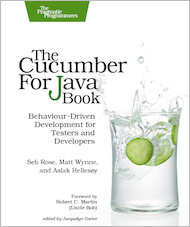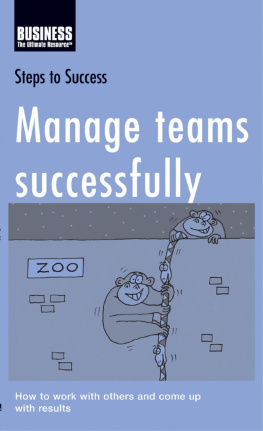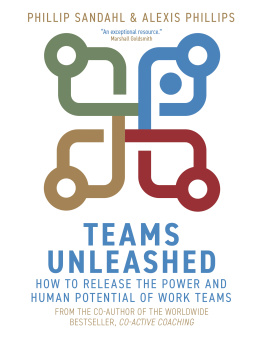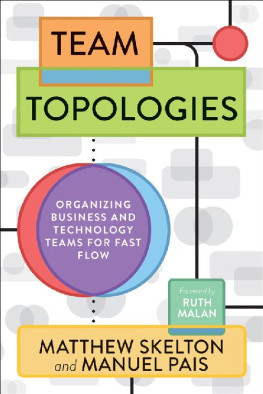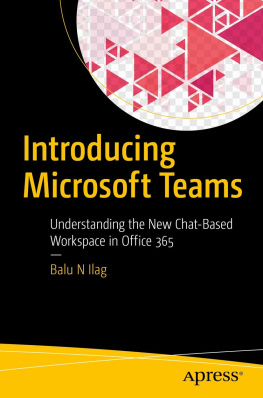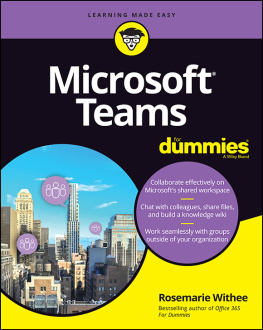Creating Great Teams
How Self-Selection Lets People Excel
by Sandy Mamoli, David Mole
Version: P1.0 (November 2015)
Copyright 2015 The Pragmatic Programmers, LLC. This book is licensed to the individual who purchased it. We don't copy-protect it because that would limit your ability to use it for your own purposes. Please don't break this trustyou can use this across all of your devices but please do not share this copy with other members of your team, with friends, or via file sharing services. Thanks.
Dave & Andy.
Many of the designations used by manufacturers and sellers to distinguish their products are claimed as trademarks. Where those designations appear in this book, and The Pragmatic Programmers, LLC was aware of a trademark claim, the designations have been printed in initial capital letters or in all capitals. The Pragmatic Starter Kit, The Pragmatic Programmer, Pragmatic Programming, Pragmatic Bookshelf and the linking g device are trademarks of The Pragmatic Programmers, LLC.
Every precaution was taken in the preparation of this book. However, the publisher assumes no responsibility for errors or omissions, or for damages that may result from the use of information (including program listings) contained herein.
Our Pragmatic courses, workshops, and other products can help you and your team create better software and have more fun. For more information, as well as the latest Pragmatic titles, please visit us at http://pragprog.com.
The team that produced this book includes:
Katharine Dvorak (editor)
Linda Recktenwald (copyeditor)
Dave Thomas (typesetter)
Janet Furlow (producer)
Ellie Callahan (support)
For international rights, please contact .
For the Best Reading Experience...
We strongly recommend that you read this book with the publisher defaults setting enabled for your reading device or application. Certain formats and characters may not display correctly without this setting. Please refer to the instructions for your reader on how to enable the publisher defaults setting.
Table of Contents
Introduction: Self-Selection
and Why You Should Care |
Copyright 2015, The Pragmatic Bookshelf.
Early praise for Creating Great Teams: How Self-Selection Lets People Excel
Teams are the fuel that powers the agile engine. In this book Sandy and David explore self-selection, a process that helps professionals organize themselves into effective teams. The detailed descriptions of the why and how of self-selection and the many examples make this a very useful book. I highly recommend it!
| Ben Linders |
| Independent consultant in agile, lean, quality, and continuous improvement |
This is dynamite! I now realize how much I wish I had had a book like this earlier. It provides a hands-on path on how to harness peoples motivation through self-selection! I read it in just one go. Nice structure. Great language. Concrete. Inspiring. Love it!
| Jimmy Janln |
| Agile coach, Crisp and Nomad8 |
Ive believed for a long time in the power of self-selection, so I am excited that there is finally a handbook on how to go about it. Sandy and David give concrete advice on facilitating self-selection within an organization and what to look out for. Anyone reading this book will feel prepared to embark on what otherwise might seem like a very scary journey. I will definitely recommend it to coaches and organizations I work with.
| Karen Greaves |
| Agile coach and trainer, Growing Agile |
I love this book! Ive wondered about self-selection and how I might do it. I usually ask teams to self-select, but very simply and only with two teams. This book has provided me with step-by-step guidelines on how to scale my approach. I particularly love the section on what you should do before a self-selection eventan often overlooked part.
| Samantha Laing |
| Agile coach, Growing Agile |
In Creating Great Teams , youll find guidance for building your strongest teams through self-selection. For most managers, its a leap of faith, and the authors ensure a softer landing. They describe their experiences with self-selection in detail. You follow along with helpful checklists. In the end, you learn to trust that you will have the right people focused on the right work. Im a fan of great liftoff activities for teams, and this one is outstanding. The self-selection process prepares people to do their best work and stay engaged. I look forward to sharing this book with managers and team leaders.
| Diana Larson |
| Consultant, speaker, and co-author of Liftoff: Launching Agile Teams and Projects and Agile Retrospectives: Making Good Teams Great |
Acknowledgments
Many people have contributed to this book and wed like to say thank you to all of them!
Thank you to Julie Starr for cleaning up our language and helping us structure our thoughts; Brenda Leeuwenberg for asking difficult questions, pointing out holes and inconsistencies, and constantly challenging us; Paula Boock for pointing out what publishers actually do and making us contact The Pragmatic Bookshelf; and our editor, Katharine Dvorak, for her inspired and sane advice, her lightning speed, and her awesome editing.
Thank you also to Susannah Pfalzer, Dave Thomas, and Andy Hunt at The Pragmatic Bookshelf and all of the reviewers: Alessandro Bahgat, Jacob Chae, Derek Graham, Alexander Henry, Aaron Kalair, Nigel Lowry, Matthew Margolis, Loren Sands-Ramshaw, Tibor Simic, Federico Tomassetti, and Colin Yates.
A special thank you goes to Trade Me, which trusted its employees to solve a complex problem and let us write about it.
Copyright 2015, The Pragmatic Bookshelf.
Foreword
As a consultant and expert in organizational dynamics, Ive worked with scores of organizations, and over the course of four decades, Ive observed hundreds of teams and team formations. In many of those cases, the focus was assembling the required mix of technical skillsas if the skills existed apart from the people who had them.
Many years ago, I worked for a big, multinational corporation. The company had technology centers spread over every time zone. Every possible skill was represented somewhere in the company. Couldnt we save money and avoid hiring new people if we could make efficient use of those resources? an executive wondered.
Every technical employee filled out a profile and became an entry in what was called the Global Skills Inventory (GSI) database. When the executives approved a new initiative, a manager created a skills list and cranked up the database. The manager fed in the requirements andboom!the GSI spit out a list of resources deployed for the project team.
Its easy to see the faulty reasoning behind the GSI database. People are not interchangeable units, and technical skills are only part of the equation when people need to work collaboratively.
But what about the traditional way, relying on management judgment to form teams? Ive seen selection processes range from very informalwhat my friend and fellow agile coach Don Gray calls the Five Yous Method (You, you, you, you, and you. Youre the team.)to very formal processes with job analysis, selection criteria, interviews, testing, and auditions.

